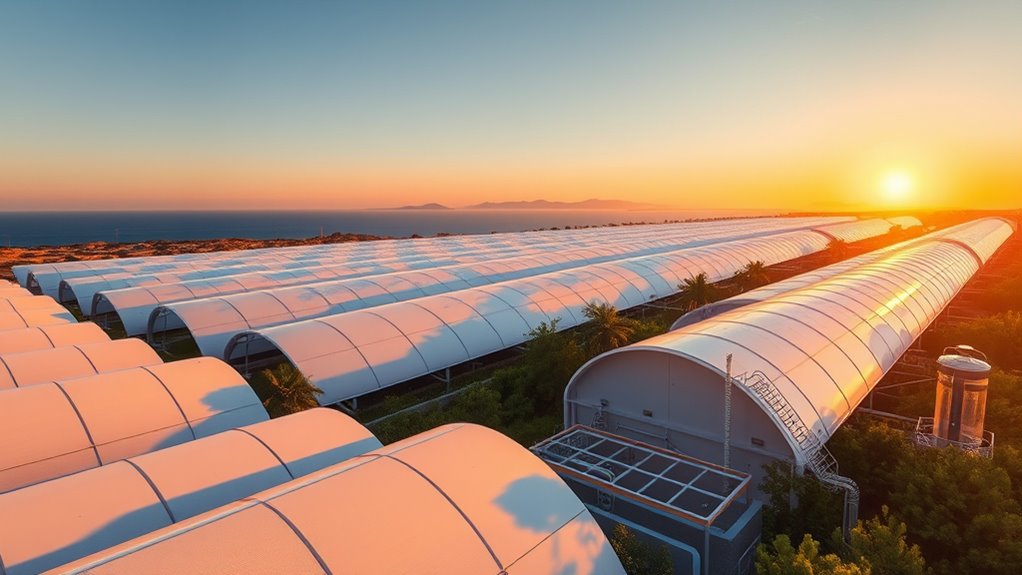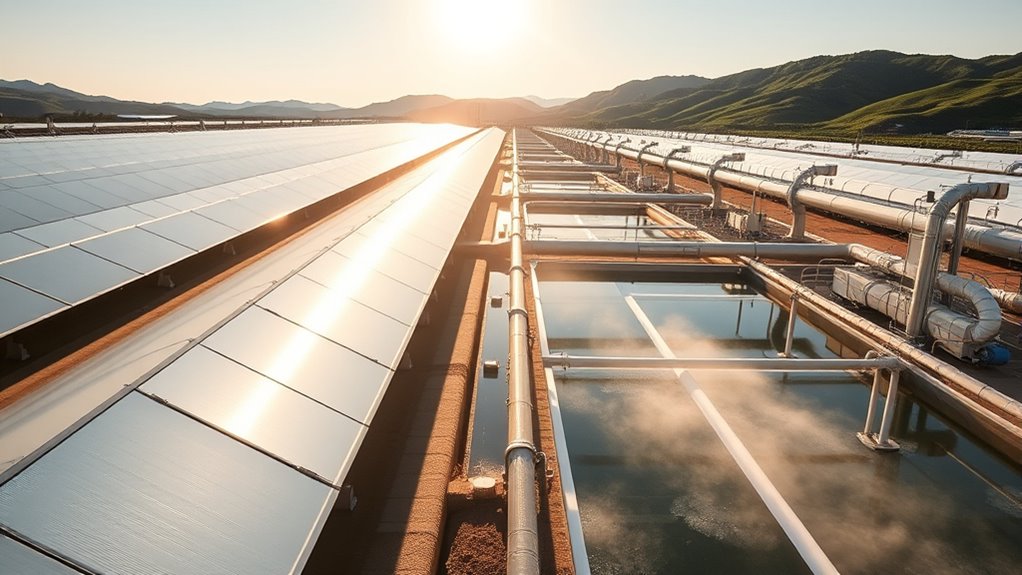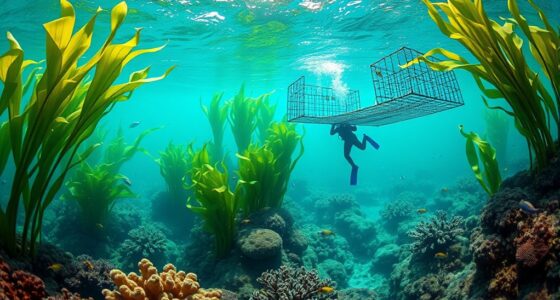Solar desalination plants turn sunshine into fresh water by using sunlight to heat seawater or generate electricity through photovoltaic panels. Thermal systems evaporate water, which then condenses as clean drinking water, while membrane technologies like reverse osmosis filter out salts. Innovative passive designs and advanced control systems improve efficiency and reduce costs. If you keep exploring, you’ll discover how these technologies help transform abundant sunlight into sustainable water solutions worldwide.
Key Takeaways
- Solar desalination uses sunlight to heat saltwater, causing evaporation and producing fresh water through condensation.
- Direct thermal systems harness solar heat, while photovoltaic-powered reverse osmosis systems use solar energy for filtration.
- Advanced control systems optimize energy use and adapt to changing sunlight, enhancing efficiency and reliability.
- Passive solar designs utilize natural convection and layered materials to evaporate and condense water without mechanical parts.
- Integrating solar energy reduces environmental impact and operational costs, making desalination more sustainable and accessible.

Solar desalination plants harness the sun’s energy to produce fresh water from seawater or brackish sources, offering a sustainable alternative to traditional methods. These systems use different technologies to convert salty or brackish water into drinking water, primarily relying on solar power to reduce reliance on fossil fuels. The most common approach is direct (thermal) solar desalination, where sunlight heats salt water, causing it to evaporate. The vapor then condenses into fresh water, leaving salts and impurities behind. This method is simple and effective but often requires large solar collectors and efficient condensation systems.
Solar desalination uses sunlight to turn seawater into fresh drinking water efficiently and sustainably.
Another popular method is indirect (photovoltaic) solar desalination, which uses solar panels to generate electricity that powers desalination units like reverse osmosis (RO) or electrodialysis (ED). RO is the dominant membrane process, accounting for nearly 70% of global desalination plants. It works by forcing seawater through semi-permeable membranes at high pressure, trapping salts and impurities while letting clean water pass through. PV-powered RO systems convert sunlight directly into DC electricity to operate high-pressure pumps, making them modular and scalable—perfect for small-scale or demonstration projects. However, they face challenges like needing pre-treatment of water to prevent membrane fouling and dealing with variable sunlight, which can affect operation consistency.
Energy storage becomes essential because PV systems don’t operate at night or during cloudy weather. Batteries can store excess energy for continuous operation but increase overall costs and introduce efficiency losses. Thermal energy storage offers an alternative by preserving heat energy, allowing systems to run after sunset. Some advanced designs aim to eliminate the need for batteries altogether by creating systems that adapt dynamically to sunlight fluctuations, improving efficiency and reducing costs. Recent advancements in control algorithms further optimize energy use and water output, making solar desalination more reliable and cost-effective.
Innovative control systems also enhance performance. These systems use real-time solar data to adjust pumping and electrical currents, ensuring desalination pace matches current sunlight conditions. This approach maximizes energy efficiency and stabilizes output without needing batteries or external power sources. They respond swiftly to passing clouds or changing light, maintaining consistent fresh water production.
Emerging designs like wick-free passive solar evaporation systems use layered materials—dark absorbers, perforated layers, and saline reservoirs—to harness solar heat efficiently. These systems rely on natural convection currents to drive water vapor, reducing complexity and maintenance while avoiding salt buildup. Overall, solar desalination is evolving rapidly, combining various technologies and control strategies to turn abundant sunshine into clean, safe drinking water sustainably. Moreover, integrating renewable energy sources into these systems can further decrease operational costs and environmental impact.
Frequently Asked Questions
How Long Do Solar Desalination Plants Typically Last?
Your question about how long solar desalination plants last is important. Typically, photovoltaic-powered plants last around 25 years, while concentrated solar power systems can operate up to 35 years. Key components like solar panels, pumps, and electronics influence lifespan. Regular maintenance, good water quality, and protective measures extend their operational life, ensuring you get reliable, cost-effective fresh water for many years.
What Is the Initial Cost of Installing a Solar Desalination System?
You’re curious about the initial costs, but what if those figures hide bigger opportunities? Installing a solar desalination system can range from $500,000 for medium-scale plants to as low as $0.34 per cubic meter with emerging tech. Costs depend on technology, scale, and location, yet advancements and competition promise reductions. So, while the upfront investment might seem steep now, innovation is steadily making clean water more affordable and accessible.
Can Solar Desalination Plants Operate During Cloudy Days?
You can operate solar desalination plants during cloudy days, thanks to various strategies. They use battery storage to save excess energy, oversized solar arrays to capture limited sunlight, and intelligent management to adjust water production. Hybrid systems can switch to backup power sources, while thermal and energy storage techniques guarantee continuous operation. These adaptations help maintain water output even when weather conditions reduce solar irradiance.
What Maintenance Is Required for Solar Desalination Facilities?
Imagine your solar plant basking in the sun’s glow, producing clean water. To keep it thriving, you need to clean the solar panels every 2-4 weeks, especially near the coast. Regularly inspect and service the photovoltaic components, monitor output, and safeguard against environmental damage. Maintain membranes, filters, pumps, and pipelines, and keep detailed logs. Training staff on safety and troubleshooting guarantees your system runs smoothly, providing fresh water day after day.
Are Solar Desalination Plants Suitable for Large-Scale Water Production?
You might wonder if solar desalination can meet big water needs. It’s suitable for large-scale production, especially with medium-scale plants that adapt to local requirements. While high initial costs and energy demands pose challenges, combining solar with grid backup and storage improves reliability. These plants can produce millions of cubic meters daily, reduce carbon footprints, and offer sustainable solutions, making them viable for extensive water supplies.
Conclusion
You can see how solar desalination plants are transforming sunny days into clean, drinkable water. Imagine that by 2030, these plants could provide over 30 million cubic meters of fresh water daily, helping millions worldwide. It’s inspiring to think that harnessing just sunlight can combat water scarcity and improve lives. As technology advances, your support for renewable solutions like this can make a real difference in creating a sustainable future for everyone.










